This was published 1 year ago
Some teachers saw him as a delinquent. Now he’s a three-hatted chef
At 23, he was running a top-end restaurant. At 27, he secured three hats in the Good Food Guide. At 28, Hugh Allen reckons he’s just getting warmed up.
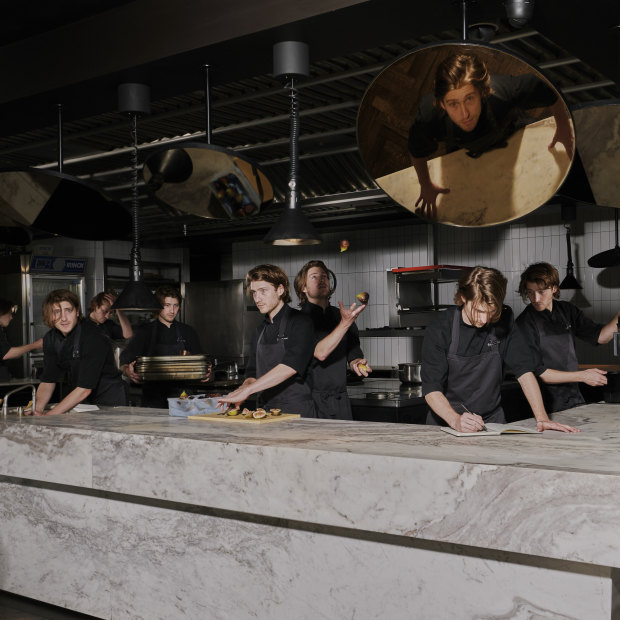
“The ‘fine dining is just for the elite’ stuff is bullshit,” says Allen in the Vue de Monde kitchen. “I’d guess 90 per cent of our guests are two teachers who’ve saved up for their end-of-year dinner, or a couple from Wangaratta who’ve come into the city for their 25th anniversary.”Credit: Kristoffer Paulsen
It’s a humid autumn evening that would seem oppressive in most cities, but this being Melbourne, we’re just grateful for the warmth. The setting is Yarra Botanica, a big barge bar on a brown river, which is packed for the 2023 Melbourne Food & Wine Festival’s opening night. The mayor’s here, a minister too, but mostly it’s celebrity chefs. Matt (sans cravat) Preston holds court by the bar. Andrew McConnell is just arriving. George Calombaris is just leaving. And off to the side stands the leader – or leading light, at least – of the next generation.
Hugh Allen is distinctive by his unassuming sartorial choices – a baggy blue shirt, almost dorky black sleeveless vest, scuffed-up Hoka sneakers – but he pulls it off. Possibly because of that unfathomably handsome face – piercing pale eyes, peering out through floppy blond fronds – perhaps because he’s a bona fide wunderkind.
He’s only just turned 28, yet his resume includes a teen apprenticeship served a few hundred metres away at Neil Perry’s Rockpool Bar & Grill on Southbank, then an award-winning turn under mentor Shannon Bennett at Melbourne institution Vue de Monde, plus a fertile stint in Copenhagen alongside the great René Redzepi at the world’s most influential restaurant, Noma. He returned home at 23 and took over from Bennett at Vue, which should probably now be called “Hugh de Monde”. After all, it took Allen only a few years to lead that legacy restaurant back to the top of the local food chain, in 2022, at age 27, securing three hats in the 2023 The Age Good Food Guide, the top accolade held by only a handful of restaurants each year.
But here’s the thing – he’s only getting started. Since he returned from Denmark in 2018, he’s had his eye on a “spectacular, derelict” space for a restaurant he hopes to open as part of the Singapore-owned Vue Group. Allen can imagine it – the fitout, feel and menu, celebrating native plants and, indeed, this city. “I’m a big Melbourne guy,” he says, smiling. “It’s my team, you know?”
He’s excited to create his own upmarket destination, even in this moment of great upheaval, as restaurateurs deal with a rapid realignment of values. What was once standard industry practice – overly aggressive kitchens, and the rampant use of unpaid interns – is now on the nose, forcing chefs to grapple with whether fine dining can and indeed will evolve to survive, or if its slow decline is inevitable.
Allen believes the former, or he wouldn’t be so jazzed about his new venture. He can’t speak to a timeline – 18 months would be nice – but wheels are in motion. Only a fortnight ago, he got the call: his dream location is practically secured. “I thought when that day came I would be like, ‘Wow! It’s happening!’ ” he says. “But really, my first thought was, ‘What’s next?’ There’s so much to do.”
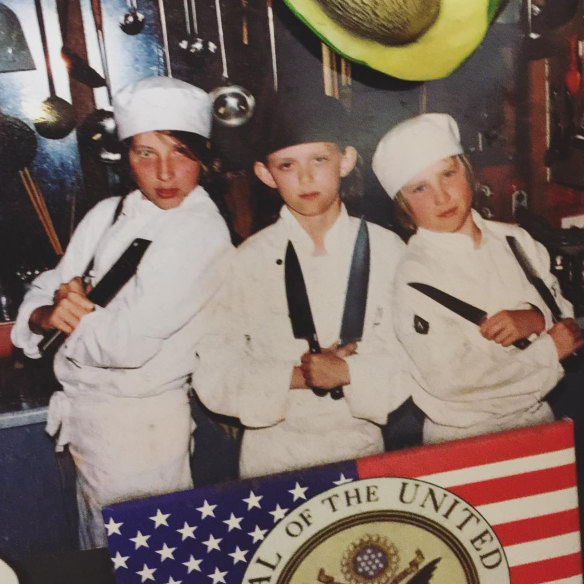
Allen, at right, with mate Morgan, middle, and brother Fraser, posing for their pretend food TV show. Credit: @hughsallen/Instagram
We’re sitting near the galley kitchen in Allen’s childhood home in North Melbourne, and I can’t help but imagine him learning to make meals at his mother’s hip. His parents, he clarifies bluntly, were terrible cooks. “Sausages on a griddle. Boiled potatoes and frozen peas. Chilli con carne from an Old El Paso kit.”
Mum Anna was a nurse who worked long hours in the neonatal intensive-care unit at The Royal Women’s Hospital, while dad Roger was a paediatric rheumatologist often on call at The Royal Children’s Hospital. Food was fuel for their three sporty boys: Allen and his twin, Fraser, a consultant with Ernst & Young, and big brother Lachie, 30, a planner with the City of Melbourne. The passion for food came from the idiot box – watching Rick Stein and Maggie Beer and Heston Blumenthal. He mimicked them all – “Lovely jubbly!” – while videotaping a pretend food TV show with his twin and a mate. “I specifically remember – and still cook it today – Jamie Oliver’s grilled swordfish with tomato salsa and beans,” says Fraser. “That was how we hung out.”
They would wander past the nearby Carlton North bistro La Luna, too, ducking in the kitchen door to get a brownie corner or sausage bite, until owner-chef Adrian Richardson (Good Chef Bad Chef) offered them work experience. Allen, 12, chopped parsley and peeled an octopus, and was hooked. He lined up for hours to get Gordon Ramsay’s new book signed. He saw the movie Ratatouille – the 2007 animated flick about a Parisian rat working in a French kitchen – three times at the cinema and a hundred times at home. It was everything he loved about cooking but couldn’t yet express. “Like watching a blacksmith making a knife,” he says, “or a glassblower creating a decanter.”
He liked his classes round the corner at University High School, but his grades were so poor that his dad took him to a clinical psychologist in case he had a learning disorder. “Hugh’s results were such a bizarre spread that she couldn’t make a conclusion,” says Roger. “But she gave him an IQ of 118, which is well above average.” (Fraser is less bemused: “Hugh was fine as a student. He just didn’t put any importance on being one.” ) Teachers saw him as a delinquent, enrolling him in the Too Cool program, where cops would lecture troublemakers about addiction and violence. “I was in this room surrounded by the kids who sold drugs or carried knives,” Allen says, laughing. “I was like, ‘How the f--- did I end up in here?’ ”
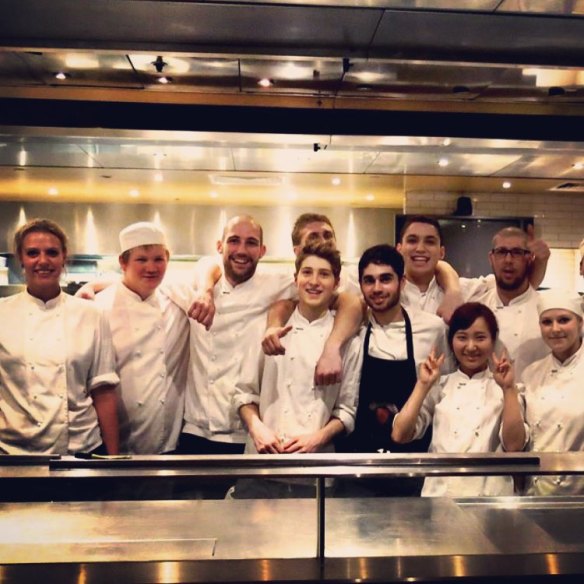
Allen, centre, in 2011 doing work experience at Rockpool.Credit: @hughsallen/Instagram
A week of work experience at Rockpool when he was 15 changed everything. “It was super hot, steamy, shit everywhere. I was so excited.” He accepted an offer to do an apprenticeship without asking his folks (who were fine with it), then left school after year 10. He knew nothing. A chef would ask for a bunch of tarragon and Allen would Google it on the way to the coolroom.
After every shift he walked across the Yarra River to the base of the Rialto building, where a TV ran a live feed from the prestigious 55th-floor kitchen of Vue de Monde, which chef and owner Shannon Bennett had opened in Carlton in 2000, then moved to Little Collins Street in 2005. It was named restaurant of the year in 2006, before shifting to the Rialto in 2011. Allen would watch Bennett and dream of joining him.
A week of work experience there at 17, followed by pestering persistence, landed him a job on “Level A” –the basement floor where produce is delivered and fish are gutted. “You get to do that quality control, get to know the farmers – their struggles and traits – and from there you can start to put a story on the plate,” Shannon Bennett says. “Hugh really embraced that.”
“He was this baby-faced gentle soul, but eager, keen ... you get a lot of chefs who come in with egos.”
One night they were short on chefs, so Allen came upstairs to help out on pastry, and never went back. Within 18 months he was ensconced. “It sounds a bit arrogant, but I was 19 and one of the best chefs by far,” Allen says. “I always had my prep done, always on point. If you fall behind in a tasting menu, it breaks the line – someone else gets slammed because of you.”
Cory Campbell, the head chef at the time – who now lives in New Zealand where he runs Auckland institution The Grove – saw confidence yet humility. “He was this baby-faced gentle soul, but eager, keen, and that’s what I loved,” says Campbell, 42. “You get a lot of chefs who come in with egos, but it’s really not about what you do, it’s about what we do here.”
Obsessed with high-end kitchens, Allen fixed his gaze on Noma, the three-Michelin-starred restaurant known for making foraging and fermentation fashionable – and for being crowned number one in the World’s 50 Best Restaurants awards a record five times. Taking a big swing, he quit his job, emailed Noma to see if he could “stage” (intern) there, then in 2015 flew to Denmark before he even had an answer. He was in Copenhagen doing nothing, haemorrhaging savings, when they let him visit for a week. “Every time René walked past I’d get nervous,” Allen says. “It’s like if you dreamed of being a basketballer, and then Michael Jordan is walking past you in the change room.”
He knew Noma would soon close for four months in Copenhagen to do a 10-week pop-up in Sydney, for which it was flying 85 staff to Australia, so he told them he’d be around if they needed help. “I had no intention of being back in Australia, but I flew back, then started texting to say, ‘I’m around if you need me’.” He worked for free at Noma Australia for part of its 2016 pop-up, using ingredients he’d never seen, from native river mints to lemon myrtle.
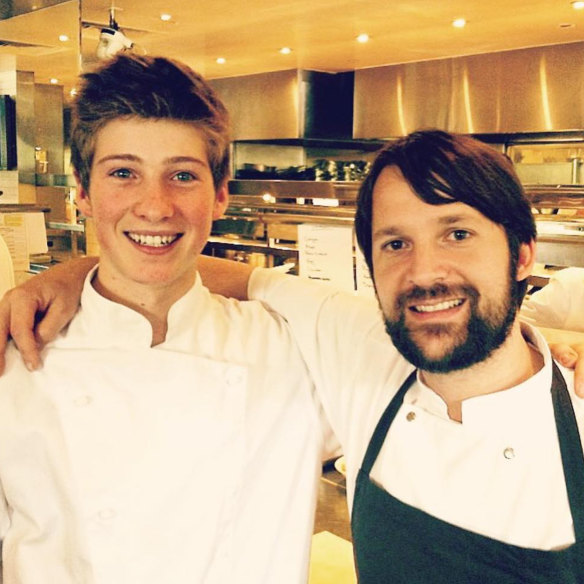
Allen as a starstruck teen with René Redzepi in 2011, when the legendary Danish chef visited Melbourne.Credit: @hughsallen/Instagram
Then he was off to France. He’d won a prestigious award in 2015 at Vue de Monde – named “Potentialist of the Year” by restaurant guide Gault&Millau Australia – which included a six-month tour of markets, restaurants and wineries in Monaco, Nice, Lyon and Alsace, visiting ancient wine caves once raided by Nazis, and dining in the Dom Perignon chateau, before staging in Paris at a pair of three Michelin star restaurants, Le Pré Catelan and Le Cinq.
Noma emailed as the tour concluded – “We’ve got a space available – when can you get here?” – but he was already in Copenhagen. “I didn’t want to say I was in Denmark, waiting and hoping, but I was literally around the corner.”
He spent three formative years at Noma, marvelling at the vast operation, working on pop-ups at wine bars and under bridges. One on the Riviera Maya in Tulum, Mexico – in a mangrove jungle “restaurant” with a sand-floor kitchen – seduced him with fresh coconut water and cactus fruits and chillies, and the old Mayan women who made tortillas for every service. He befriended the famed René Redzepi, who used to say to his chefs that if they were a soccer team, they were Arsenal or Paris Saint-Germain, meaning each chef had to be Messi or Mbappe. Every night there was a new high-profile guest – Spanish chef Ferran Adriá, a member of the Dutch royal family, Justin Timberlake – and all expected a once-in-a-lifetime performance.
“I always talk about it like The Lord of the Rings, and the burden of carrying the ring – the way that expectation takes you over,” says Allen. “René would go absolutely ballistic sometimes – mental like I’ve never seen – but he would never want to. We could see it coming as a crew – he’s clicking, clapping, and we’re almost smirking like, ‘Okay, who’s he gonna lose it on?’ ”
One night in Mexico, American Express had bought out the restaurant – corporate evenings are one way such pop-ups make money – and Allen was the target. He was flipping a tostada, unaware Redzepi had asked (twice) if they were crispy. “The next minute I was getting grabbed – ‘Motherf---er! Are you ignoring me? Who the f--- do you think you are?’ – but 10 minutes later the service ends and he comes up – ‘Chef, I’m so sorry’ – and then we’re going for a chat and a paddle in the ocean. I understood how difficult it was, being him.”
Allen came home for family, not fame. It was the end of 2018 when he began to understand that his parents were quite sick. His dad had stage-three bowel cancer, and mum stage-four melanoma. “But I wasn’t getting fed the full story, and I was starting to struggle with the drip-feed,” Allen says. “I started f---ing up at work – my head was in different places.” He finally asked his dad about his mum: “How bad is it?” (It wasn’t good.) “I bought a ticket that night, flew home the next day, left all my shit in Copenhagen, emailed Noma to thank them for everything, but family comes first.”
His mum is still in treatment but has had no active melanoma since, and his dad is almost five years clear. Allen, home and without a job, emailed Bennett and returned to Vue de Monde as a sous chef. His timing was perfect. In 2016, Bennett had sold a majority stake in his restaurant portfolio to the Far East Organisation, a developer based in Singapore, and planned to move to Byron Bay with his partner and six kids. He needed a succession plan. “Hugh always had this glint in his eye,” Bennett says. “He just reminded me of me.”
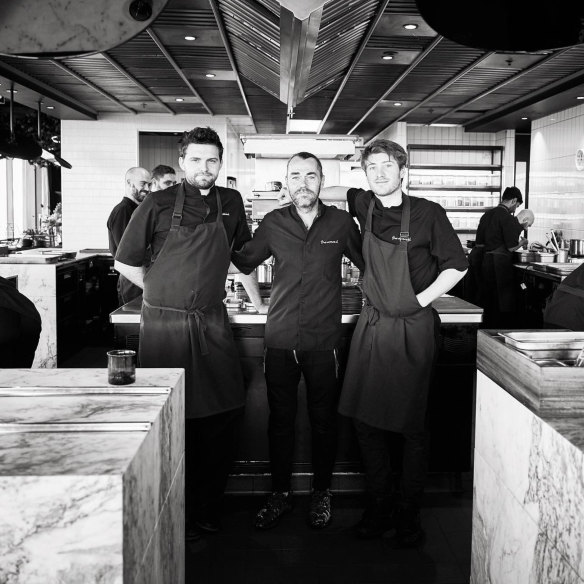
Allen with Shannon Bennett (centre) and Vue de Monde’s head chef Chris Marshall in 2019. Credit: @hughsallen/Instagram
Bennett made his surprise pitch: the 55-seat restaurant needed new energy and someone young he could trust to carry on its legacy. It needed Allen, in whom Bennett saw a calm character and clear communicator, with intuition, discipline and pedigree. All Allen could sputter were doubts. He was 23, and the most he had ever done was run a section. “I had to instil in Hugh that he was ready,” says Bennett. “And to explain that it wasn’t just ‘Here’s the keys, see you later mate.’ I’d help him adjust.”
Sceptics were easy to find, like general manager Hugo Simoes – now the longest-serving member of staff at nine years. “He’s too young,” Simoes told Bennett. “It’s going to be difficult for him to assert himself. This is the wrong move. A big mistake.” A senior chef there left, too, both parties signing a legal agreement not to discuss one another. Allen understands: “I knew how I’d feel if I’d been working there ages, and then Shannon’s little golden child comes along.”
“It’s going to be difficult for him to assert himself. This is the wrong move. A big mistake.”
He began by meeting with critics and peers, and imitating former bosses in the kitchen, while slowly changing dishes on the tasting menu. The pandemic fell as he hit his stride. Based atop a skyscraper in the most locked-down city on Earth, he couldn’t do anything. They opened and shut. Opened and shut again. But he was fortunate. JobKeeper covered most employees, and Far East stepped in to pay those who weren’t eligible, from foreign staff to recent hires.
His profile was quietly growing, too, thanks to a guest spot on MasterChef. He didn’t like it at first – the swarming set, producers in his earpiece, doing five takes because he was smiling too much or not enough. “I barely spoke. They were desperately trying to get me to say more.” He gets stopped for a selfie at least once a week now, but has little interest in TV shows or cookbooks. “He’s got a touch of the tortured artist,” says Michael Harry, food and lifestyle publisher at Hardie Grant Books. “I don’t know if he loves his Prince Charming moniker.”
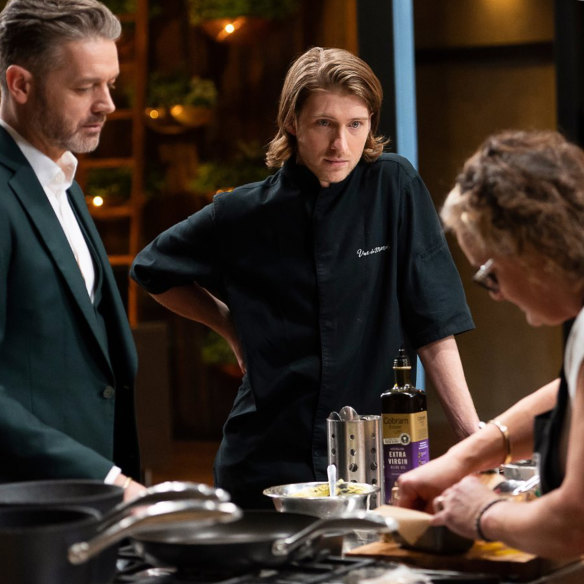
Allen on MasterChef last year.Credit: @hughsallen/Instagram
He had more immediate goals, anyway. Vue de Monde had lost its third hat in 2017, and Allen wanted it back. Bennett says Allen – who grew up reading and revering the guide – was “demoralised” by the lost hat. “But that hurt and pain and sense of failure really spurs you on,” says Bennett. “The best way to become number one is to think like you’re number two.”
Allen began clawing back Vue’s stature with new dishes that thrilled, from the theatre of grilling wattleseed damper at the table to accompany a West Australian marron tail rising from a bowl of velvety, rich curry, to the way he paraded a side of wagyu beef with an explanatory soliloquy that would be at home in The Man from Snowy River. He placed more emphasis on guest experience, too – kitchen tours and courses served on the balcony – and on rare ingredients, from enormous sea snails to a Tasmanian wasabi leaf. Good Food Guide reviewers gave the restaurant an 18 out of 20 in 2021, and again in 2022, at which point Allen, just 27, became the youngest Australian chef to be awarded three hats in 30 years. [The youngest ever came in 1983, when Andrew McIldowney took over from Iain Hewitson at Clichy in Collingwood, Melbourne, and was awarded three hats at the age of 21].
Hugh Allen runs a tight ship, and it starts in his management meeting. On the March day I visit, a handful of senior staff run through everything from fire evacuation training to the slipping standard of staff footwear. (“I think we went from cool sneakers to runners,” Allen tells them, “and it swung too far.” ) Then the front-of-house meeting with a dozen servers and sommeliers begins. I’m staying for dinner service, and to blend in I wear a chef’s tunic and apron, and stand at attention as they prepare. This includes sharing the research they’ve gathered on each guest. They know, for instance, that dinner on table four is a treat for someone after a bad fall, and that the guy on table five is planning to propose (with an engagement ring to be revealed from under a polished cloche). There are notes on returning visitors, too, from “prefers tap water” to “acted as though they were in a pub”.
In any office there’s a quiet industrious hum when hard work is being done well, and that’s the case in the open kitchen. Wallace Yang, a 33-year-old pastry chef from Taiwan, presses white chocolate and plum into the shape of a leaf, then caramelises it with a blast from a Makita heat gun – the kind you would use to strip paint from weatherboards. Frenchman Mathias Troubat, 25, stands plucking and sorting edible flower petals. (When I eat at the restaurant, they’ll be placed in a bowl with liquid nitrogen, and like all other guests I’ll use a wooden pestle to smash them into shards – a floral dust coating for a dollop of fennel sorbet.)
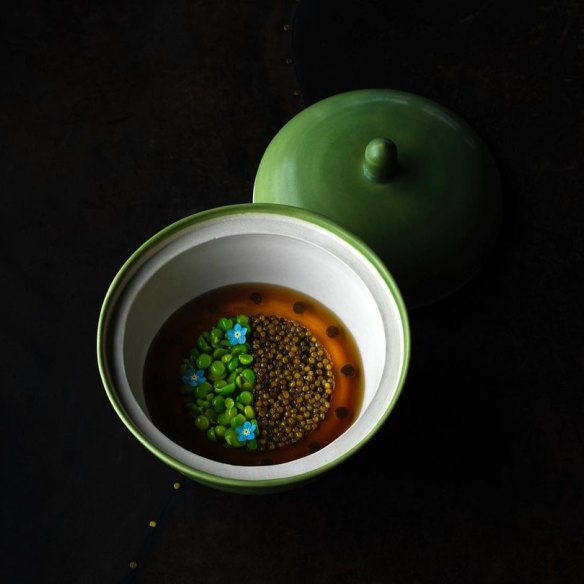
Macadamia and smoked eel tofu with kelp jelly, peas and caviar.Credit: @hughsallen/Instagram
Cucumber pearls are compressed, smoked kelp is tweezed, and slivers of avocado are curled into cones the size of a thimble. Tristan Spain, 22, is keen to explain why three gigantic pots – as big as garbage bins – sit bubbling on the induction stove, filled with 32 kilograms of roasted Maryland-cut chicken, wings and feet. “The bones will give the stock its flavour,” he says, “the gelatin its syrupy consistency.”
Allen floats gently between sections, more designer than doer. He didn’t eat out much growing up and always felt a certain anxiety at fancy fooderies, so he conceived a first course specifically to put customers at ease. The tiny bowl of peeled, smoked tomatoes in a chilled vine-reduction broth is served immediately, so uninitiated guests won’t have time to feel uneasy. Literal
comfort food.
He didn’t eat out much growing up and always felt a certain anxiety at fancy fooderies, so he conceived a first course specifically to put customers at ease.
Then there are dishes designed to amaze, like the petits fours presented on a “rig” of spiralling eucalyptus leaves. Allen loves watching people ponder the bite-sized wattleseed and white chocolate gumnut: dessert or decoration? “They’re almost reluctant to bite it,” he says, laughing. “They look at you like, ‘Are you trying to mess with me?’ ”
Then there are those dishes earned through experimentation. His favourite is the Byron Bay macadamia tofu with smoked eel from Skipton (near Ballarat). Getting the concoction to set correctly meant playing ad infinitum with the ratio between three types of the thickening agent carrageenan, derived from red seaweed (a brittle-set Kappa, a silky Iota and a thickening Lambda). “It was a bitch,” he says. “I failed for three months.”
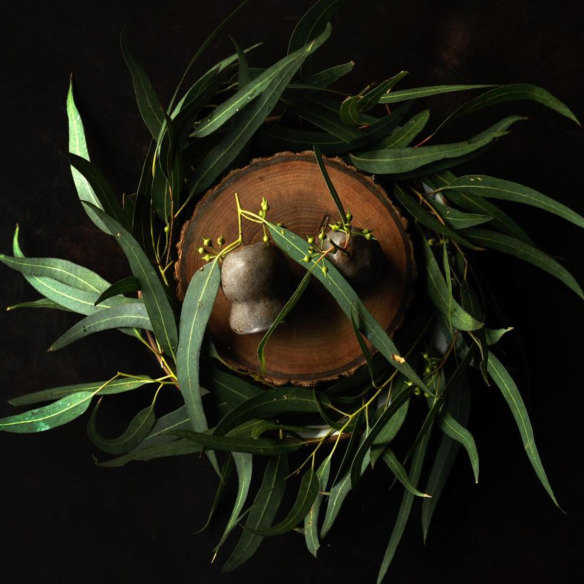
Wattleseed and chocolate gumnuts: Allen says guests are “almost reluctant to bite it”.Credit: @hughsallen/Instagram
It seems strange – while talking about a chef’s mad-scientist moments – to think that fine dining might be dying, but that became the dominant worldwide dining-industry narrative following a January story in The New York Times, in which René Redzepi announced that he would close Noma at the end of 2024. The hours, expense, effort and outdated use of free labour through an army of “stagiaires” (unpaid interns), meant Redzepi would focus instead on “Noma 3.0″: a Wonka-esque food lab; and roaming pop-ups of the same high-end food without the fixed overheads, like one beginning last month in Kyoto. His admission – that fine dining had become “unsustainable” – echoed across the globe like crystal stemware shattering on a restaurant floor.
“I’ve never had more requests for interviews than that week,” says Allen. “It was out of control.” He posted an Instagram story into the swirl of overwrought commentary. Aspirational dining would not die, Allen wrote, comparing great restaurants with musical genres. Escoffier was opera. Troisgros was classical. French Laundry was jazz. El Bulli and Fat Duck were the blues. “Noma was rock ‘n’ roll,” he wrote. “History tells us there will be a hip-hop, etc.”
He shows me a text message exchange, too, between him and Redzepi, in which the latter complains of journalists misconstruing his words: “This is not the end. I don’t see it as the end. We want to make it better,” he texted to Allen. “They have no idea.”
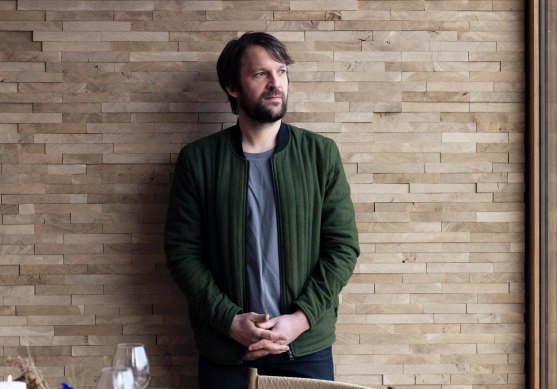
René Redzepi announced that Noma would close at the end of 2024.Credit: Jason Loucas
The planned closure might not be a harbinger. Noma remains an outlier – a unique operation including a fermentation lab, test kitchen, production kitchen, then a service kitchen – requiring roughly 30 unpaid interns and 34 paid cooks. Michael McAuley, 24, was one of the former before becoming the latter, then followed Allen from Noma to Vue de Monde. With a Scottish accent as thick as [insert witty food simile here], McAuley says he has no problem with unpaid internships, likening the sacrifice to paying tuition fees at the London School of Economics. “If you want to go to a top school, you’ll probably need to take out a loan,” he says. “It’s about what it does for you after you’ve been there.”
Allen got his starts at Rockpool, Vue de Monde and Noma through unpaid work, and wants to say yes to chefs who email him weekly hoping for the same. “But we’re too big to get caught up in a Fair Work Commission complaint,” he says. “Maybe there should be a cap? Maybe a set ratio of interns to staff? Maybe a time limit – interning only for a few months? But no interns at all – that’s just bad for young chefs.”
One of the country’s leading employment lawyers, Maurice Blackburn principal Josh Bornstein, who has led several recent restorative legal actions against major restaurant groups, points out that employers need to ask a critical question – Who is getting the benefit here? – when determining the potential for internships to turn exploitative. “There is a fine line between providing training or unpaid work experience, and unpaid employment,” he says. “The latter is illegal.”
“Sometimes you want to yell, ‘Please, tie your f---ing hair up – are you trying to test my patience?’ But if you did that now, you would have no one left. You can’t run a kitchen by fear.”
Wages are only one thread in the recent re-examination of restaurants. The TV drama The Bear won awards for its depiction of an intoxicating yet toxic kitchen culture, but industry experts say the “angry chef” trope is in recession. “Sometimes you want to yell, ‘Please, tie your f---ing hair up – are you trying to test my patience?’ ” admits Allen. “But if you did that now, you would have no one left. You can’t run a kitchen by fear.”
There’s also the Ralph Fiennes film The Menu, which lampoons chefs and critics, egotistical investors and insufferable foodies. Allen liked it, with a caveat. “It was just a movie – a creative, scary, wacky little black comedy,” he says. “We’re in an intense environment, but most of the time we’re talking shit all day, having beers afterwards, and playing sport together on weekends.”
Yet the movie did capture the bizarre aura surrounding the “genius chef” and their contempt for the diner, implicit in overly performative marathon meals. Allen’s heard this one before, too. He speaks of food instead as though it were haute couture, sounding like Meryl Streep’s haughty magazine editor from The Devil Wears Prada. Remember when she gives Anne Hathaway a dressing-down for not realising that her lumpy, blue jumper – her anti-fashion choice – was born in the halls of high fashion before filtering down into the bargain bin? “Same with restaurants,” Allen says. “Cooks look at the new ground being broken at the top, and recreate that in a more approachable way.”
“Degustation is dead” headlines are probably too easy to be real. Ardyn Bernoth, national Good Food editor, says variations appear every few years. She wrote one a decade ago. “We ran a photo of a red wine glass spilt on a white tablecloth, painting this picture of blood on the streets,” Bernoth says. “Maybe fine dining doesn’t die, but it does change and adapt. There are these ripples.”
That white tablecloth, for instance, did eventually become a stuffy anachronism, seen in restaurants less and less. Once paired with starchy service, diners also came to expect warmth from highly professional hosts. The pandemic supercharged this vibe shift. Forced to explore their suburbs during lockdown, people are eating more locally. They’re making (and keeping) fewer dinner reservations. Remote work and normcore fashion have dovetailed neatly into the casualisation of dining.
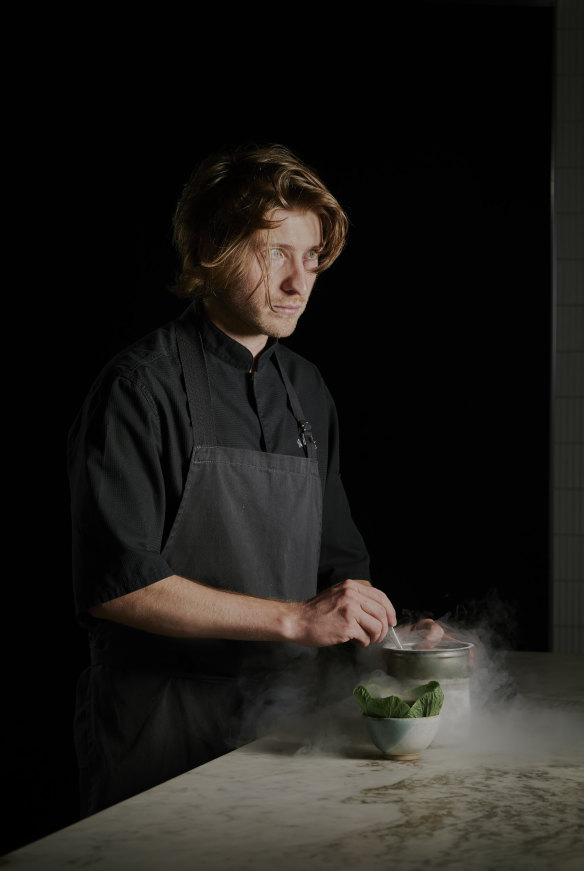
“Cooks look at the new ground being broken at the top, and recreate that in a more approachable way,” Allen says of the influence of fine dining.Credit: Kristoffer Paulsen
But fancy food is going nowhere. There have been no other announced closures at the level of Noma. Indeed, luxetarian venues are flying their staff halfway around the world for pop-ups, including a pair of three Michelin star restaurants to Sydney. French fine diner Mirazur – the world’s best restaurant in 2019 – took over The Gantry at Dawes Point last month ($685 per person), while L’Enclume opens at Bathers’ Pavilion at Balmoral Beach for five weeks this winter ($420 per person).
Allen points out that Vue de Monde – at $350 per person for the food alone – is a bargain compared to comparable restaurants in Paris (Le Pré Catelan, $610) or London (Kitchen Table, $540) or New York (Eleven Madison Park, $550). “Even the ‘fine dining is just for the elite’ stuff is bullshit,” he says. “I’d guess 90 per cent of our guests are two teachers who’ve saved up for their end-of-year dinner, or a couple from Wangaratta who’ve come into the city for their 25th anniversary.”
Vue de Monde’s own 25th anniversary isn’t far away, and consequently, the space needs a refresh. Allen sits in meetings with architects for a refurbishment next spring. The tables will be reupholstered in new kangaroo leather, and each will have its own gentle spotlight for perfect iPhone photos. “It’s unfortunate we have to design around that,” he says, “but we do.”
The bar will expand, too. There’ll be new artworks, but not dictated by Allen’s personal taste, which includes the rough Mornington Peninsula landscapes of local painter Baden Croft, and the post-Impressionism of Henri Matisse. “I could probably press the case,” he says, “but I don’t own this place.”
He’s a chapter in a book. Guests have been eating the chocolate soufflé with billy tea ice-cream since Bennett opened his small bistro in Carlton, and they’ll continue doing so in whatever iteration it takes. “But in a new venue,” Allen says, “I can be more radical.”
He has a great relationship with Far East, and will need it. You can’t build something to fit his ambition with investment from a few wealthy doctors. “There’s nothing wrong with K-mart clothing, but if I was starting a brand I’d want to be a Louis Vuitton – the highest-level fabric and craftsmanship for the discerning buyer,” he says.
“If I wanted to open a little restaurant in Elm Street, North Melbourne, I could do that tomorrow, and it would probably be full, but I would get bored in about three seconds.”
Back on the barge at Yarra Botanica, we’re offered copious canapés – mussels on sourdough toast and smoked celeriac skewers – but Allen declines them all, happily sipping from a can of pale ale. He’s still somewhat anonymous in mainstream Australia, but not in this crowd – and full celebrity-chef status is coming.
“When I was young,” he says (which, frankly, sounds absurd coming from someone not yet 30), “I never thought I would be at a top, top place. But if this new thing comes off, I’ll be able to achieve what I want to achieve.” In the meantime, he takes nothing for granted. “When the doors open and the guests are walking in,” he says, nodding, “that’s when I’ll pinch myself.”
To read more from Good Weekend magazine, visit our page at The Sydney Morning Herald, The Age and Brisbane Times.
correction
This article originally stated that Hugh Allen was the youngest chef to ever secure three Good Food Guide hats. He is the youngest in 30 years. [Andrew McIldowney was chef at Clichy in Collingwood in 1983, when it was awarded three hats. Then 21, McIldowney had just taken over from founding chef Iain Hewitson.]